
Saint Eigrad or Eugrad was a sixth-century Welsh saint [1] and the founder of St Eugrad's Church in Llaneugrad, Anglesey. [2]

Saint Eigrad or Eugrad was a sixth-century Welsh saint [1] and the founder of St Eugrad's Church in Llaneugrad, Anglesey. [2]
Eigrad is mentioned in Caradoc's Life of Gildas (12th century). [3] He was a son of king Caw of Strathclyde, a brother of saints Gildas, [4] and Samson of York [5] and was a student of Saint Illtud. [6]
In 605 AD [7] he founded a church at Llaneugrad, Anglesey [8] [9] and his brother Gallgo, founded a church at Llanallgo, nearby. [10] Today the two churches are in the same parish.
His feast day is 6 January.

Llanedeyrn is a former village, now a district and community, in the east of the city of Cardiff, Wales, located around 3.5 miles from the city centre. The parish of Llanedeyrn rests on the banks of the river Rhymney and is visible nesting on a hill side above the A48(M), westbound on the approach into Cardiff.
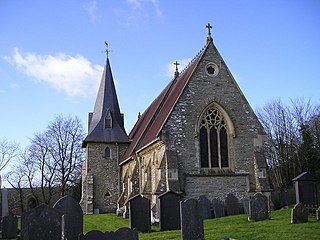
Saint Cynllo is a British saint, who lived in the late 5th and early 6th centuries, generally described as a brother of Saint Teilo. Cynllo was known for "...the sanctity of his life and the austerity of his manners."
Saint Peulan was a Welsh holy man in the early part of the 6th century, the son of Paulinus, a saint from south Wales who taught Saint David. A follower of Cybi, a saint associated with the island of Anglesey in north Wales, Peulan is commemorated in the dedication of the church he reportedly founded, St Peulan's Church, Llanbeulan, on Anglesey.
Saint Cwyllog was a Christian holy woman who was active in Anglesey, Wales, in the early 6th century. The daughter, sister and niece of saints, she is said to have founded St Cwyllog's Church, Llangwyllog, in the middle of Anglesey, where a church is still dedicated to her.

St Fflewin's Church, Llanfflewin is a small rural church, situated by a farm in Anglesey, Wales. The first church on the site is said to have been built by St Fflewin in 630, but the present building has no structural features dating from before the 18th century, although the church has a font from the 14th or 15th century and part of an inscribed medieval gravestone has been reused in a window sill.

St Tyfrydog's Church, Llandyfrydog is a small medieval church, in Llandyfrydog, Anglesey, north Wales. The date of establishment of a church on this site is unknown, but one 19th-century Anglesey historian says that it was about 450. The oldest parts of the present building are dated to about 1400, with the chancel dating from the late 15th or early 16th century. It is built from rough, small, squared stones, dressed with limestone. One of the windows on the south side is raised to illuminate the pulpit, a decision that in the eyes of one 19th-century commentator "disfigures the building."
Tyfrydog was a Christian from north-west Wales in the fifth or sixth century, who was later venerated as a saint. He is said to have established a church in Anglesey, and although no part of the original structure remains, the current church is still dedicated to him. A nearby standing stone is said to be the remains of a man who he punished for stealing a bible from the church.

St Ffinan's Church, Llanffinan is a small 19th-century parish church built in the Romanesque revival style, in Anglesey, north Wales. There has been a church in this area, even if not on this precise location, since at least 1254, and 19th-century writers state that St Ffinan established the first church here in the 7th century. The church was rebuilt in 1841, reusing a 12th-century font and 18th-century memorials, as well as the cross at the eastern end of the roof.
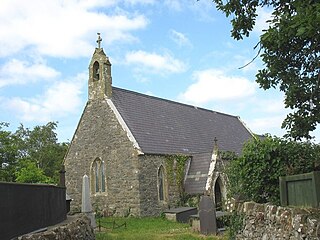
St Deiniol's Church, Llanddaniel Fab, is a small 19th-century parish church in the centre of Llanddaniel Fab, a village in Anglesey, north Wales. The first church in this location is said to have been established by St Deiniol Fab in 616. He was the son of St Deiniol, the first Bishop of Bangor. The current building, which is in Early English style, incorporates some material and fittings from an earlier church on the site, including the font and an 18th-century memorial in the porch. The vestry door has medieval jambs and the keystone of its arch, which is also medieval, is a carved human face. Some parts of the nave walls may also come from a previous building here.
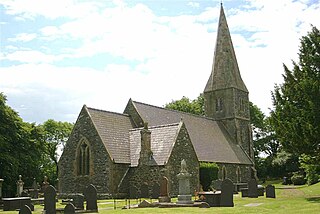
St Caffo's Church, Llangaffo is a 19th-century church, in the south of Anglesey, north Wales, about 5 miles (8.0 km) from the county town, Llangefni. It was constructed in 1846 to replace the previous medieval church in the village of Llangaffo. The new building includes a number of monuments from the old church, and has a spire which is a prominent local landmark. The churchyard has part of a stone cross dating from the 9th or 10th century, and some gravestones from the 9th to 11th centuries. It is dedicated to St Caffo, a 6th-century martyr who was killed in the vicinity.
Caffo was a sixth-century Christian in Anglesey, north Wales, who is venerated as a saint and martyr. The son of a king from northern Britain who took shelter in Anglesey, Caffo was a companion of St Cybi, and is mentioned as carrying a red-hot coal in his clothes to Cybi without his clothes getting burnt. After leaving Cybi, Caffo was killed by shepherds in the south of Anglesey, possibly acting in retaliation for insults Caffo's brother had paid to the local ruler. The area where he died has a village, Llangaffo, named after him, as well as the parish church of St Caffo, Llangaffo.

St Caian's Church, Tregaian, also known as St Caean's Church, Tregaean, is a small medieval church dating from the 14th century in Anglesey, north Wales. It is dedicated to St Caian, a Christian from the 5th or 6th century about whom little is known. The building contains a late 14th-century east window and a late 15th-century doorway. The churchyard contains the grave of William ap Howel, who died in 1581 at the age of 105, leaving over forty children between the ages of 8 and 89 and over three hundred living descendants.

St Gallgo's Church, Llanallgo is a small church near the village of Llanallgo, on the east coast of Anglesey, north Wales. The chancel and transepts, which are the oldest features of the present building, date from the late 15th century, but there has been a church on the site since the 6th or early 7th century, making it one of the oldest Christian sites in Anglesey. Some restoration and enlargement took place during the 19th century.

The Old Church of St Gwenllwyfo, Llanwenllwyfo is a medieval ruined church near Dulas, in Anglesey, Wales, perhaps built in the 15th century to replace another church from which only the 12th-century font survived. Dedicated to Gwenllwyfo, a 7th-century female saint about whom nothing else is known, it was used as a chapel of ease for the church in Amlwch, about 5 miles (8 km) away. Restored in 1610 and again in the 18th and 19th centuries, it contained an oak screen and pulpit from 1610.

St Nidan's Church, Llanidan is a 19th-century parish church near the village of Brynsiencyn, in Anglesey, north Wales. Built between 1839 and 1843, it replaced the Old Church of St Nidan, Llanidan, which needed significant repair, providing a place of Anglican worship nearer to the village than the old church. Some items were moved here from the old church, including the 13th-century font, two bells from the 14th and 15th century, and a reliquary thought to hold the remains of St Nidan. The tower at the west end has been described as "top heavy" and looking like "a water tower".

St Eugrad's Church, Llaneugrad is an isolated church near the village of Marian-glas, in Anglesey, north Wales. A church was supposedly founded here by St Eugrad in about 605, although the earliest parts of the present structure are the nave, chancel and chancel arch, which date from the 12th century. A side chapel was added to the north in the 16th century, and some moderate restoration work was carried out in the 19th century. It contains a 12th-century font, a 13th-century carved stone depicting the crucifixion, and a memorial to one of the officers killed when the Royal Charter sank off Anglesey in 1859.
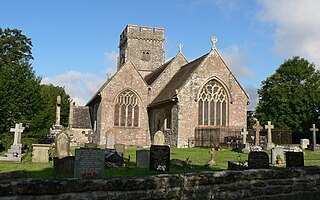
The Parish Church of St Hilary is a Grade II* listed Anglican church in the village of St Hilary in the Vale of Glamorgan, south Wales. It is one of 11 churches in the Parish of Cowbridge. It became a listed building on 22 February 1963.
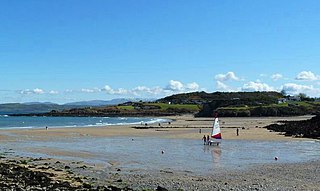
Llaneugrad is a community in Anglesey, Wales. It is located on the east coast of the island, 7.2 miles (11.6 km) south east of Amlwch, 9.8 miles (15.8 km) north west of Menai Bridge and 6.7 miles (10.8 km) north east of Llangefni, and includes the village of Marian-glas. At the 2001 census the community had a population of 273.

Saint Einion Frenin was a late 5th- and early 6th-century Welsh confessor and saint of the Celtic Church. His feast day was originally given as 9 February, although this had moved to the 10th or 12th by the 16th century and is no longer observed by either the Anglican or Catholic church in Wales.
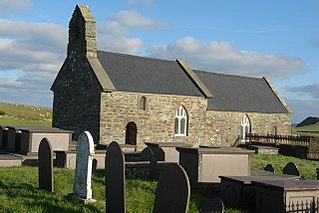
Rhwydrys is a 6th-century Pre-Congregational Saint of Wales.